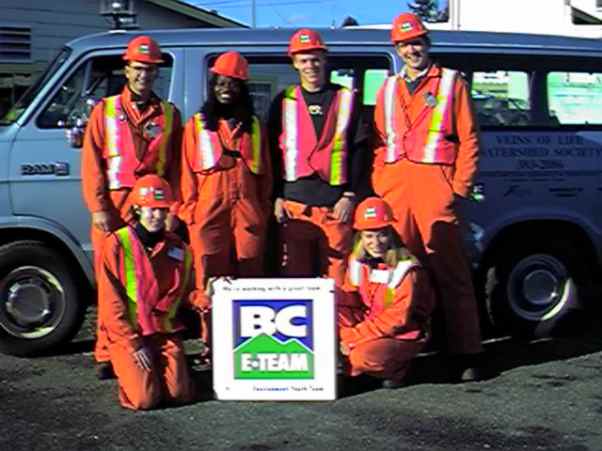| Hello! We are the Saanich Dye Test
E-Team from the Veins of Life Watershed Society. Our
team has two immediate goals. We want to locate all cross-connections
between the sanitary and storm sewers in the Dysart catchment
area and in the neighbourhoods adjacent to the Gorge, west of
Tillicum Road.
We also want to encourage residents along the Gorge to become
environmental stewards.

Left to Right (Top) Aaron Hurlburt, MR.ia Moulton,
David Major, Michael Stevens
(Bottom) Pascal Stokes, Sarah Badesso
The Dysart catchment area encompasses all the homes that drain
into the sanitary sewer pump station at the north end of Dysart
Road, adjacent to the estuary of Colquitz Creek. Longer term,
we strive towards re-establishing the Gorge waterway as a recreation
hotspot for local residents! With continued community co-operation
this will soon be a reality.
The main challenge the Dysart Catchment sanitary sewers faces
is from freshwater that is entering the sanitary system after
heavy rainfall; this has caused raw sewage, also unscreened,
to overflow from the local Dysart pump station into Colquitz
Creek — once one of Victoria's most productive salmon streams.

In other neighbourhoods adjacent to the Gorge Waterway, freshwater
entering the sanitary sewer threatens marine water quality.
There are many pump stations along the Gorge that help lift
sewage over hills on its journey to the Macauley Point deep-sea
outfall. These pumps normally operate without incident. However,
during power outages, which often coincide with heavy winter
storms, those pumps without back-up power may temporarily be
out of operation. It is at these times that the pump stations
are most vulnerable to overflowing into the Gorge, and any rainwater
in the sanitary system will further stress the system.
By detecting and correcting cross-connections between the storm
and sanitary sewers, water quality in the Gorge will greatly
improve.
What is a "cross-connection"?
A cross-connection occurs between sanitary (sewer) lines and
storm drain lines. The term inflow and infiltration
is used to describe the sources of connection to either the
sanitary or the storm lines. Freshwater may enter the
sanitary lines through infiltration from accidental connections
to the storm lines. In more severe and troublesome cases, there
may be infiltration of sewage from sanitary to the storm drain
lines. Inflow describes the seepage of groundwater into
sanitary and storm lines through breeches in the piping.

How are cross connections detected?
Dye testing is a simple method of detecting cross-connections.
During dye testing, members of our Saanich team go door-to-door
and flush a non-toxic biodegradable dye tablet down all toilets,
laundry facilities, and storm drains. Other team members are
posted at nearby manholes where they watch for the dye to appear
in the correct line or drain. Another method to detect cross-connections
is Smoke Testing.
-Join us for a day of Dye Testing!
|